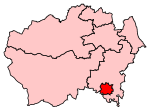Skerne Bridge
Buildings and structures in DarlingtonGrade I listed buildings in County DurhamGrade I listed railway bridges and viaductsRail transport in DarlingtonRailway bridges in County Durham ... and 3 more
Scheduled monuments in County DurhamStockton and Darlington RailwayUse British English from April 2021

The Skerne Bridge is a railway bridge over the River Skerne in Darlington, County Durham. Built in 1825 for the Stockton and Darlington Railway, it carried the first train on the opening day, 27 September 1825 (1825-09-27). It is still in use, being the oldest railway bridge in continuous use in the world. It is a Grade I listed building.
Excerpt from the Wikipedia article Skerne Bridge (License: CC BY-SA 3.0, Authors, Images).Skerne Bridge
Albert Road,
Geographical coordinates (GPS) Address Nearby Places Show on map
Geographical coordinates (GPS)
| Latitude | Longitude |
|---|---|
| N 54.534444444444 ° | E -1.5506111111111 ° |
Address
Skerne Bridge
Albert Road
DL1 2JQ , Rise Carr
England, United Kingdom
Open on Google Maps









